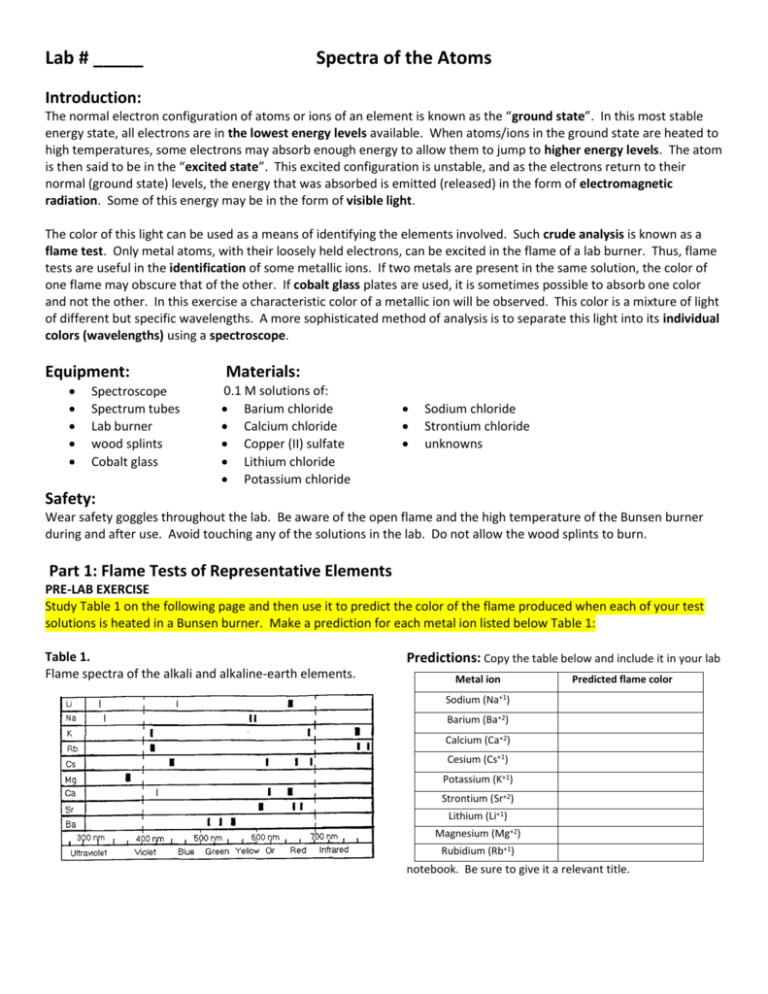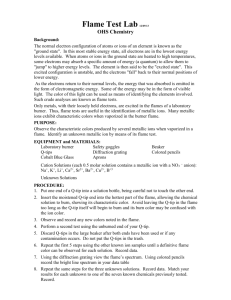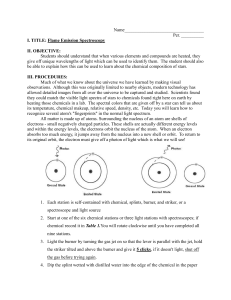Lab - yooschem1314
advertisement

Lab # _____ Spectra of the Atoms Introduction: The normal electron configuration of atoms or ions of an element is known as the “ground state”. In this most stable energy state, all electrons are in the lowest energy levels available. When atoms/ions in the ground state are heated to high temperatures, some electrons may absorb enough energy to allow them to jump to higher energy levels. The atom is then said to be in the “excited state”. This excited configuration is unstable, and as the electrons return to their normal (ground state) levels, the energy that was absorbed is emitted (released) in the form of electromagnetic radiation. Some of this energy may be in the form of visible light. The color of this light can be used as a means of identifying the elements involved. Such crude analysis is known as a flame test. Only metal atoms, with their loosely held electrons, can be excited in the flame of a lab burner. Thus, flame tests are useful in the identification of some metallic ions. If two metals are present in the same solution, the color of one flame may obscure that of the other. If cobalt glass plates are used, it is sometimes possible to absorb one color and not the other. In this exercise a characteristic color of a metallic ion will be observed. This color is a mixture of light of different but specific wavelengths. A more sophisticated method of analysis is to separate this light into its individual colors (wavelengths) using a spectroscope. Equipment: Spectroscope Spectrum tubes Lab burner wood splints Cobalt glass Materials: 0.1 M solutions of: Barium chloride Calcium chloride Copper (II) sulfate Lithium chloride Potassium chloride Sodium chloride Strontium chloride unknowns Safety: Wear safety goggles throughout the lab. Be aware of the open flame and the high temperature of the Bunsen burner during and after use. Avoid touching any of the solutions in the lab. Do not allow the wood splints to burn. Part 1: Flame Tests of Representative Elements PRE-LAB EXERCISE Study Table 1 on the following page and then use it to predict the color of the flame produced when each of your test solutions is heated in a Bunsen burner. Make a prediction for each metal ion listed below Table 1: Table 1. Flame spectra of the alkali and alkaline-earth elements. Predictions: Copy the table below and include it in your lab Metal ion Sodium Predicted flame color (Na+1) Barium (Ba+2) Calcium (Ca+2) Cesium (Cs+1) Potassium (K+1) Strontium (Sr+2) Lithium (Li+1) Magnesium (Mg+2) Rubidium (Rb+1) notebook. Be sure to give it a relevant title. Procedure for flame tests: Flame test observations: Copy the table below and include it in your lab notebook. Be sure to give it a relevant title. Metallic ion Sodium (Na+1) Potassium (K+1) Lithium (Li+1) Calcium (Ca+2) Strontium (Sr+2) Barium (Ba+2) Copper (Cu+2) Unknowns: A B C Color in flame ID of unknown Procedure for flame tests: A. B. C. D. E. F. G. Use a piece of scrap paper to make a diagram of the location of each of the known and unknown solutions (there are a total of twelve) in the well plate. Take your well plate to the stock station and fill four of the well plate depressions approximately ¼ full with four different known solutions. Return to your lab station, taking care not to allow the solutions to “slosh” and possibly contaminate one another. Dip your nichrome wire into the acid solution at your lab station and heat it in the burner flame until it is glowing red to eliminate any possible contaminates. Dip the loop end of the wire into one of the known solutions and expose the solution to the flame. Immediately observe and record the color of the flame just above the wire loop. Repeat if necessary to make accurate and thorough observations. Repeat steps c. through e. for the remaining known solutions before returning to the stock station. Follow the same procedure for each known solution. Test the copper solution last as it is most likely to contaminate the nichrome wire. Obtain the three unknown solutions as you did for known solutions. Each unknown has only one metal ion present. Perform a flame test and identify the unknown metallic ion based upon your observations of known metallic ions. You may want to do direct comparisons by observing the flame of the unknown next to the flame of a known metallic ion after you have narrowed down the possibilities for the identity. Clean Up: Rinse your well plate containing excess solutions into the waste container provided. Wipe out your plastic tray with a wet paper towel and wipe down the lab counter. Return all materials to the stock station. Part 2: Spectroscopic Observations of Gases A spectroscope separates the emitted (released) light into its parts (wavelengths) producing a bright line spectrum unique for each element. Each bright line represents the energy difference (quantum) as an electron falls from the exited state to a lower energy state. For example, in the hydrogen atom: Electron transition Color seen Increasing energy in n levels 3 to 2 Red line 4 to 2 Blue line 5 to 2 Violet line 6 to 2 Violet line The simplest type of spectroscope is called a diffraction grating. Like a prism, a diffraction grating bends light of different wavelengths to different degrees so that the light is separated into its component wavelengths. When a gas is excited by an electrical current, the bright-line spectrum can be observed through a diffraction grating. Use colored pencils or pens to record your observations of the bright line spectra of hydrogen gas, helium gas, and neon gas in the table below. Cut out the table and tape it into your lab notebook. Include a title for the diagram. H2 He Ne Wavelength Color (nm) 400 violet 500 blue green yellow 600 orange 700 red Increasing wavelength () Decreasing energy Summary: Answer the questions below in complete sentences in your lab notebook. Relate your observations of the bright line spectra to Bohr’s model of the atom. Specifically: 1. Why are there distinct bright lines as opposed to a continuous spectrum? 2. What is happening to the valence electrons to cause the bright line spectrum? 3. Why does helium have a bright line spectrum different from the bright line spectrum of hydrogen? 4. How does the bright line spectrum for hydrogen support the Bohr model of the atom?








